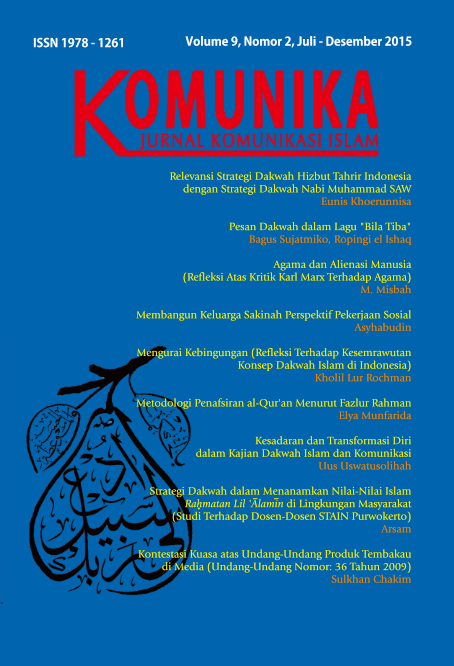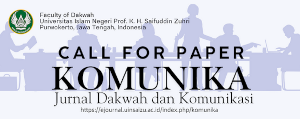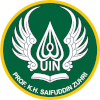MEMBANGUN KELUARGA SAKINAH PERSPEKTIF PEKERJAAN SOSIAL
DOI:
https://doi.org/10.24090/komunika.v9i2.850Keywords:
Keluarga, Sakinah, Pekerjaan SosialAbstract
The family is a mirror to society. We can see what has occured and will occur in society by looking at families who live in the community. Advancement of a society is often caused by the advancement of families in the community. Vice versa, the backwardness of a society is a sign of the backwardness of families in the community. Family is the perfect university for the actors of various roles in public life. An ideal family is a sakinah family where mawaddah and rahmah are properly maintained and always preserved so that serenity and peace in the family is getting stronger. To keep the family being sakinah, in the perspective of social work, it needs three factors, namely congruent communication, the balance of relationships within the family system and the constant mutual efforts in giving goodnessto each other in the family. Three experts in the disciplines of social work contribute ideas and concepts on this regards. The article attempts to describe the thinking of the experts to elaborate their thoughts briefly. Keluarga merupakan cermin masyarakat. kita bisa melihat apa yang sudah terjadi dan akan muncul di masyarakat dengan melihat keluargakeluarga yang hidup dalam komunitas. Kemajuan masyarakat seringkali disebabkan oleh kemajuan keluarga. Sebaliknya, kemunduran masyarakat merupakan tanda kemunduran keluarga. Keluarga adalah tempat yang sempurna bagi aktor sosial untuk berkiprah di ruang publik. Keluarga yang ideal adalah keluarga sakinah, di mana mawaddah dan rahmah selalu dijaga dengan baik sehingga kedamaian dalam keluarga semakin kuat. Untuk menjaga keluarga agar tetap sakinah, dalam perspektif kerja sosial, dibutuhkan tiga faktor, yakni: komunikasi yang harmonis, keseimbangan hubungan dalam sistem keluarga dan saling berupaya untuk memberikan kebaikan bagi masing-masing anggota keluarga. Tiga tokoh dalam kerja sosial memberikan ide-ide dan konsep tentang persoalan ini yang didiskusikan dalam artikel ini secara mendalam.Downloads
Download data is not yet available.
References
Al-Jauhari, Mahmud Muhammad dan Khayyal, Muhammad Abdul Hakim. Membangun Keluarga Qur’ani: Panduan untuk Wanita Muslimah. Jakarta: Amzah, 2005.
Jan, White. “ Family Therapy†dalam Martin Davies (ed.), The Blackkwell Companion to Social Work. Second ed. Massachusetts: Blackwell Publishing, 2002.
Shihab, M. Quraish. Membumikan Al-Qur’an: Fungsi dan Peran Wahyu dalam Kehidupan Masyarakat. Bandung: Mizan, 1992.
————, Wawasan Al-Quran: Tafsir Maudlu’i atas Pelbagai Persoalan Umat. Bandung: Mizan, 1996.
Zastrow, Charles H. The Practice of Social Work. California: Brooks/Cole Publishing, 1999.
Jan, White. “ Family Therapy†dalam Martin Davies (ed.), The Blackkwell Companion to Social Work. Second ed. Massachusetts: Blackwell Publishing, 2002.
Shihab, M. Quraish. Membumikan Al-Qur’an: Fungsi dan Peran Wahyu dalam Kehidupan Masyarakat. Bandung: Mizan, 1992.
————, Wawasan Al-Quran: Tafsir Maudlu’i atas Pelbagai Persoalan Umat. Bandung: Mizan, 1996.
Zastrow, Charles H. The Practice of Social Work. California: Brooks/Cole Publishing, 1999.
Downloads
Published
2017-01-26
Issue
Section
Articles
License
Authors who publish with this journal agree to the following terms:
- Authors retain copyright and grant the journal right of first publication with the work simultaneously licensed under a Creative Commons Attribution-ShareAlike 4.0 International License that allows others to share the work with an acknowledgement of the work's authorship and initial publication in this journal.
- Authors are able to enter into separate, additional contractual arrangements for the non-exclusive distribution of the journal's published version of the work (e.g., post it to an institutional repository or publish it in a book), with an acknowledgement of its initial publication in this journal.
- Authors are permitted and encouraged to post their work online (e.g., in institutional repositories or on their website) prior to and during the submission process, as it can lead to productive exchanges, as well as earlier and greater citation of published work (See The Effect of Open Access).

























